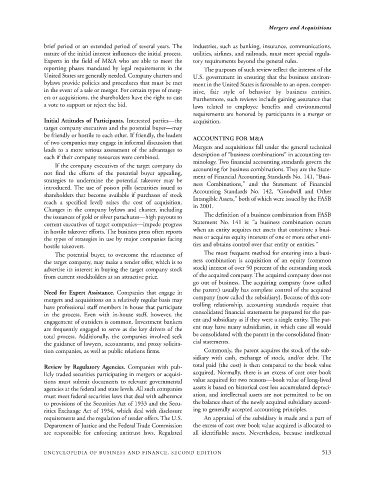Page 536 - Encyclopedia of Business and Finance
P. 536
eobf_M 7/5/06 3:15 PM Page 513
Mergers and Acquisitions
brief period or an extended period of several years. The industries, such as banking, insurance, communications,
nature of the initial interest influences the initial process. utilities, airlines, and railroads, must meet special regula-
Experts in the field of M&A who are able to meet the tory requirements beyond the general rules.
reporting phases mandated by legal requirements in the The purposes of such review reflect the interest of the
United States are generally needed. Company charters and U.S. government in ensuring that the business environ-
bylaws provide policies and procedures that must be met ment in the United States is favorable to an open, compet-
in the event of a sale or merger. For certain types of merg- itive, fair style of behavior by business entities.
ers or acquisitions, the shareholders have the right to cast Furthermore, such reviews include gaining assurance that
a vote to support or reject the bid. laws related to employee benefits and environmental
requirements are honored by participants in a merger or
Initial Attitudes of Participants. Interested parties—the acquisition.
target company executives and the potential buyer—may
be friendly or hostile to each other. If friendly, the leaders
ACCOUNTING FOR M&A
of two companies may engage in informal discussion that
leads to a more serious assessment of the advantages to Mergers and acquisitions fall under the general technical
description of “business combinations” in accounting ter-
each if their company resources were combined.
minology. Two financial accounting standards govern the
If the company executives of the target company do
not find the efforts of the potential buyer appealing, accounting for business combinations. They are the State-
ment of Financial Accounting Standards No. 141, “Busi-
strategies to undermine the potential takeover may be ness Combinations,” and the Statement of Financial
introduced. The use of poison pills (securities issued to
shareholders that become available if purchases of stock Accounting Standards No. 142, “Goodwill and Other
Intangible Assets,” both of which were issued by the FASB
reach a specified level) raises the cost of acquisition.
in 2001.
Changes in the company bylaws and charter, including
the issuances of gold or silver parachutes—high payouts to The definition of a business combination from FASB
current executives of target companies—impede progress Statement No. 141 is: “a business combination occurs
in hostile takeover efforts. The business press often reports when an entity acquires net assets that constitute a busi-
the types of strategies in use by major companies facing ness or acquires equity interests of one or more other enti-
hostile takeovers. ties and obtains control over that entity or entities.”
The potential buyer, to overcome the reluctance of The most frequent method for entering into a busi-
the target company, may make a tender offer, which is to ness combination is acquisition of an equity (common
advertise its interest in buying the target company stock stock) interest of over 50 percent of the outstanding stock
from current stockholders at an attractive price. of the acquired company. The acquired company does not
go out of business. The acquiring company (now called
the parent) usually has complete control of the acquired
Need for Expert Assistance. Companies that engage in
mergers and acquisitions on a relatively regular basis may company (now called the subsidiary). Because of this con-
trolling relationship, accounting standards require that
have professional staff members in house that participate
consolidated financial statements be prepared for the par-
in the process. Even with in-house staff, however, the
ent and subsidiary as if they were a single entity. The par-
engagement of outsiders is common. Investment bankers
ent may have many subsidiaries, in which case all would
are frequently engaged to serve as the key drivers of the
total process. Additionally, the companies involved seek be consolidated with the parent in the consolidated finan-
the guidance of lawyers, accountants, and proxy solicita- cial statements.
tion companies, as well as public relations firms. Commonly, the parent acquires the stock of the sub-
sidiary with cash, exchange of stock, and/or debt. The
Review by Regulatory Agencies. Companies with pub- total paid (the cost) is then compared to the book value
licly traded securities participating in mergers or acquisi- acquired. Normally, there is an excess of cost over book
tions must submit documents to relevant governmental value acquired for two reasons—book value of long-lived
agencies at the federal and state levels. All such companies assets is based on historical cost less accumulated depreci-
must meet federal securities laws that deal with adherence ation, and intellectual assets are not permitted to be on
to provisions of the Securities Act of 1933 and the Secu- the balance sheet of the newly acquired subsidiary accord-
rities Exchange Act of 1934, which deal with disclosure ing to generally accepted accounting principles.
requirements and the regulation of tender offers. The U.S. An appraisal of the subsidiary is made and a part of
Department of Justice and the Federal Trade Commission the excess of cost over book value acquired is allocated to
are responsible for enforcing antitrust laws. Regulated all identifiable assets. Nevertheless, because intellectual
ENCYCLOPEDIA OF BUSINESS AND FINANCE, SECOND EDITION 513

